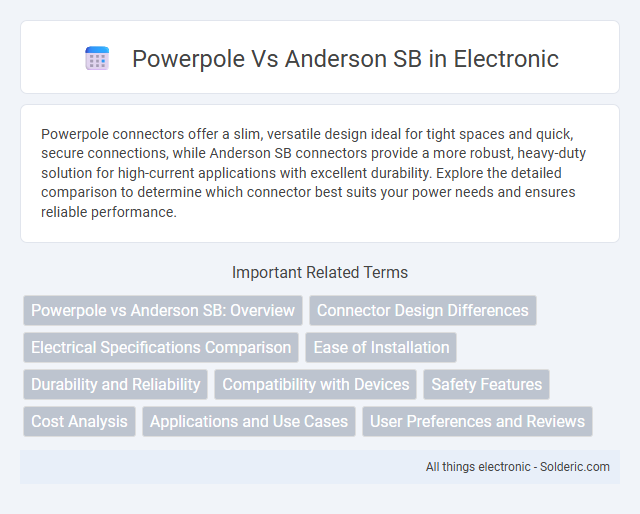Powerpole connectors offer a slim, versatile design ideal for tight spaces and quick, secure connections, while Anderson SB connectors provide a more robust, heavy-duty solution for high-current applications with excellent durability. Explore the detailed comparison to determine which connector best suits your power needs and ensures reliable performance.
Comparison Table
| Feature | Powerpole | Anderson SB |
|---|---|---|
| Connector Type | Modular, genderless | Gendered, modular |
| Current Rating | 15-45 Amps (varies by model) | 15-350 Amps (varies by model) |
| Voltage Rating | Up to 600V DC | Up to 600V DC |
| Contact Material | Silver-plated copper | Silver-plated copper |
| Polarity | Color-coded housing for polarity | Red/black housings for polarity |
| Ease of Use | Quick connect, stackable | Requires more space, secure locking |
| Applications | Ham radio, RC, small electronics | Industrial, automotive, high current setups |
| Size | Compact and lightweight | Bulkier, robust build |
| Price Range | Generally lower cost | Higher cost, depending on amperage |
Powerpole vs Anderson SB: Overview
Powerpole connectors offer a compact, modular design favored for quick, reliable, and secure electrical connections in amateur radio and RC applications. Anderson SB connectors are renowned for their durability, high current capacity, and ease of use in industrial and automotive power distribution. Your choice between Powerpole vs Anderson SB depends on the specific current rating, size constraints, and environmental conditions of your project.
Connector Design Differences
Powerpole connectors feature a modular, color-coded housing system that allows for easy stacking and customization, making them ideal for versatile power distribution setups. Anderson SB connectors have a robust, genderless design with a twist-lock mechanism, ensuring secure, high-current connections suitable for industrial and automotive applications. Your choice depends on whether you prioritize modular flexibility or rugged, high-current reliability in your connector design.
Electrical Specifications Comparison
Powerpole connectors typically support currents up to 45A at 600V, while Anderson SB connectors handle higher currents, often rated for 50A to 350A depending on the model, with voltage ratings up to 600V or more. Powerpole connectors feature gold-plated copper contacts that provide low contact resistance and consistent electrical performance, whereas Anderson SB connectors use silver-plated contacts designed for high current and durability. Both connector types ensure secure, stable connections suitable for DC power applications but differ in current capacity, contact materials, and modularity, influencing their suitability for various electrical systems.
Ease of Installation
Powerpole connectors offer a user-friendly design with a simple color-coded system that ensures quick and intuitive installation, making them ideal for users with limited technical experience. Anderson SB connectors provide a robust and secure connection but typically require more precise alignment and sometimes specialized tools for proper assembly. Your choice depends on whether you prioritize fast, straightforward installation (Powerpole) or a durable, high-current connection that may necessitate additional effort (Anderson SB).
Durability and Reliability
Powerpole connectors offer superior durability with their robust, high-quality plastic housing and strong, corrosion-resistant copper contacts, ensuring reliable performance in harsh conditions. Anderson SB connectors feature a rugged design with high-current capacity and secure locking mechanisms, making them highly dependable for heavy-duty applications. Your choice depends on specific power requirements and environmental factors influencing connector longevity.
Compatibility with Devices
Powerpole connectors are highly compatible with a wide range of amateur radio equipment, battery systems, and DC power devices due to their modular design and standard sizes ranging from 15 to 45 amps. Anderson SB connectors support higher current capacities up to 350 amps and are frequently used in industrial machinery, electric vehicles, and solar installations, offering compatibility with heavy-duty devices. Their distinct locking mechanisms and form factors often require adapters for cross-compatibility between Powerpole and Anderson SB connectors.
Safety Features
Powerpole connectors feature color-coded housings and standardized contact arrangements that reduce reverse polarity risks, enhancing connection safety. Anderson SB connectors incorporate a keyed design and robust, high-current contacts that minimize accidental disconnects and electrical arcing. Your choice between Powerpole and Anderson SB should consider these safety mechanisms to ensure reliable and secure power connections.
Cost Analysis
Powerpole connectors typically have a lower upfront cost, making them a budget-friendly choice for hobbyists and small-scale projects. In contrast, Anderson SB connectors, while more expensive initially, offer greater durability and higher current capacity, potentially reducing long-term replacement and maintenance expenses. Evaluating total cost of ownership often favors Anderson SB connectors in professional or high-demand applications due to their robust construction and reliability.
Applications and Use Cases
Powerpole connectors excel in low-voltage DC power applications such as amateur radio, solar power systems, and portable electronics due to their modular design and ease of use. Anderson SB connectors are widely used in higher current settings like electric vehicles, industrial equipment, and large battery packs, offering robust, high-amperage handling and secure connections. Your choice between Powerpole and Anderson SB should depend on the current requirements and environmental conditions of your specific application.
User Preferences and Reviews
User preferences between Powerpole and Anderson SB connectors often hinge on ease of use, durability, and application type. Powerpole connectors receive high praise for their modular design and simple stacking capability, making them favored in amateur radio and DIY electronics communities. Anderson SB connectors are appreciated for their robust construction and higher current ratings, fitting professional and industrial setups where reliability under heavy load is critical.
Powerpole vs Anderson SB Infographic

 solderic.com
solderic.com